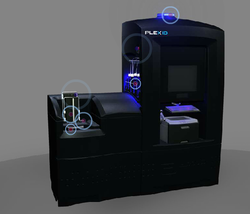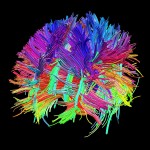 New Scientist reports that a pharmaceutical company has developed a machine that can tell you what virus, bacteria, or fungus is making you sick. The machine is called the Plex-ID universal biosensor. In the simplest terms, saliva or blood goes in, and a determination of the offending pathogen comes out. The process current takes 8 hours, but a new machine under development can do it in five. Aside from the total Star Trek nature of this (Computer - Please scan the patient and determine what is making them sick), it is awesome because it could allow doctors to prescribe the right medication for the culprit. Theoretically, patients will feel better faster and the development of antibiotic resistance bacteria will be slowed. So, how does it work? - Step 1 - The Bead Beater - Mechanical agitation is used to maximize the amount of nucleic acids (ie DNA) available for extraction
- Step 2 - Sample Preparation - Magnetic particle separation is used to extract the DNA/RNA from the sample
- Step 3- PCR Plate Setup - Samples are injected into individual wells on a "Polymerase Chain Reaction" plate. This is basically a grid of test tubes prefilled with different materials to test against the samples.
- Step 4 - PCR - The PCR plate is exposed to cycles of heat to activate the reactions.
- Step 5 - Desalting - A magnetic substrate is injected to bind to the DNA material. All other compounds (salts, etc) from the PCR process are washed away. The magnetic material is than recaptured with a magnet leaving only the DNA for analysis.
- Step 6 - Electrospray Ionization - DNA molecules are tested via mass spectrometry, which produces a chart of the relative amount of each compound present in the sample.
- Step 7 - Organism Identification - The mass spectrometry result is compared to a database of known pathogens to determine if any were present in the sample.
So, sure, it takes a long time, our database is somewhat limited, and you do have to extract blood or saliva, but this is still pretty rad.
I am a fairly practically minded person. I studied mechanical engineering in school. Houses, people, and giant earthworms are about the size of things I understand. When it comes to contemplating the very, very large or the very, very small, I get nervous. I sing cartoon theme songs from my childhood in my head. But someone out there in interweb is made of stronger stuff then I am. Check out this amazing tool to experiment with the Scale of the Universe. You can move the slider bar and learn about the what things out there are what size. It is astonishingly well done, and didn't inspire me to even a single chorus about ninja turtles.
 This poster won an honorable mention in the 2012 International Science and Engineering Visualization Challenge. It illustrates about 4.6 billion years of Earth's to the time that there are the first signs of life. It shows what is going on with the earth's geology - plate tectonics, how the continents are moving around the globe, etc. It also has information about the chemical makeup of the atmosphere and how that is affecting life. And in the top right hand corner
Brain, meet Big Data. The Human Connectodome Project is an effort by a multidisciplinary group of scientists, engineers, and computer scientists to understand the wiring stored in the human skull. The initial effort is to scan the brains of 1200 people with an MRI to collect detailed data on brain patterns. The MRI data will be combined with genetic information and behavioral information to understand the interaction between the human brain and human behavior with a data density that would have been hard to fathom even a decade ago. Aside from making really pretty pictures, why does it really matter to know the routes that info travels around in our brains? In the words of the director of the NIH: "With a detailed connectome map of a normal human brain, I believe we will gain a better understanding of the roots of human neurological disorders, including schizophrenia, autism spectrum disorders, and other baffling conditions that may arise from abnormal “wiring” during brain development. This knowledge should yield new and better ways to detect, treat, and, ultimately, prevent the brain disorders that currently disrupt and devastate so many lives.
The connectome will also give us a new tool to explore how genes influence the brain’s connections—and how behavioral and environmental factors act to sculpt those connections, affecting everything from our ability to solve crossword puzzles to our risk for addiction.Image Credits: Human Connectodome Project
Air pollution in China has been much in the news this month. A great blog post on Washington Post shows two aerial images of China from January 3rd and 14th. The difference is astounding, and by all accounts a respirator sales should probably be increasing. | | Full Face Respirator:
Don't Leave Home Without It! | I lived in Los Angeles for five years, so I like to think I know a little something about air pollution. J and I would joke that since the air temperature is similar year round, the only way you can tell winter from summer is if the air is clear enough to see the San Gabriel mountains to the north or not. But the truth is environmental regulation has done wonders for air pollution in LA in the last few decades. A colleague of mine who grew up there in the 70s related a story of the first time the air was clear enough to see the mountains, he asked his mother where they came from. It had always been so hazy, the mountains couldn't be seen for years, even in winter. For me, the snowcapped mountains in the distance is one of the most resounding images from my time there.

Smog in LA circa 1970 (left) and 2012 (right)
| | Like most things in life, smog is way more complicated than is convenient - a combination of natural processes (wildfires, dust storms, volcanos, etc), human activities, and atmospheric conditions (ie how easy it is for the pollution to move away from the source). It reminded me of this amazing video simulation of how aerosol particles, a main component of smog, move around the globe. Enjoy!
Rice University has some fun science learning games posted on the internet. They are aimed at middle or high school students, but I figure that just makes them more fun! I took the science career quiz and it determined that I might like being an Epidemiologist or a Neural Psychologist. According to the site, epidemiology might be for you if you like working with people (questionable), have good math skills (strong), and enjoy detective work/uncovering mysteries (very strong). According to J, the majority of my pleasure reading is about either a lady detective, a lady wizard, or ideally a lady wizard detective. I didn't see lady, scientist, wizard detective on the careers but I still find this interesting. Neural Psychology is about how the brain affects people's behavior. While I find this very interesting, I'm not sure that I would like working in a clinical environment. As an aside, the games revealing what a neural psychologist does with their day strongly suggest that you don't do drugs, kiddos.
So if your current career doesn't work out, what are you going to be?
|












 RSS Feed
RSS Feed